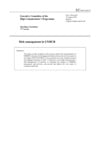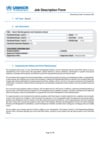Risks growing for increasing numbers of refugees and migrants crossing the Western Balkans
This is a summary of what was said by UNHCR spokesperson Adrian Edwards – to whom quoted text may be attributed – at today's press briefing at the Palais des Nations in Geneva.
UNHCR is concerned about increasing risks facing refugees and migrants in the Western Balkans with more people using this route for their journeys. Men, women and children are often walking for days, some exposed to violence and abuse, or accidents along train tracks.
What has become known as 'the Western Balkans route' is seeing a dramatic increase in refugees and migrants. Some are registering for asylum in the Balkans, others are heading onwards.
Between 2012 and 2014 the number of people registering their intention to seek asylum in the Western Balkans went from 5,000 to 20,000, a four-fold increase. So far in 2015, the numbers have been rising further, with over 22,000 asylum claims lodged in Serbia alone in the first five months of the year, a six fold increase from the same period as last year. Close to 10,000, new asylum-seekers were registered by the authorities in May alone. Authorities and civil society in Southern Serbia are currently stretched to provide basic humanitarian aid, registration and accommodation to some 200 asylum-seekers that approach them each day for help, having crossed the border from fYR Macedonia. UNHCR estimates that at least an equal number of people potentially in need of international protection forego registration, have been moving through the region irregularly, with the help of smugglers. The vast majority of them seek to reach Western Europe crossing into Hungary.
Most of those travelling this route are from refugee-producing countries, mainly Syria, Afghanistan, Iraq, Eritrea and Somalia. They mostly come via Greece, and with the recent surge in sea arrivals there, the number of people undertaking this journey is expected to grow further.
The situation is particularly difficult in the former Yugoslav Republic of Macedonia where refugees and migrants follow rail tracks and mountain routes, walking for days exposed to train accidents, natural elements and to abuse and threats from smugglers and criminal networks. A series of fatal accidents over the last few months have been a reminder of the dangers, including to young children and women.
UNHCR has been advocating for improvements to the asylum systems in this region since the early 1990s. Existing capacities are inadequate for the scale of arrivals. In particular, we have been working closely with the Government of the former Yugoslav Republic of Macedonia to amend its Law on Asylum and Temporary Protection, so that people potentially in need of international protection are registered and get access to legal processes. The proposed changes, which are still to be approved by the Parliament, urgently need adoption and implementation.
In Serbia the situation is more positive and asylum-seekers are not detained. UNHCR is working to increase its support to the efforts of authorities and civil society to provide basic assistance, services and access to procedures.
The situation remains critical and will require further support, including through joint efforts with the European Union, national Governments, and NGOs.
For more information on this topic, please contact:
- In Sarajevo, Neven Crvenkovic on mobile +387 61 611 082
- In Greece, William Spindler on mobile +41 79 217 3011
- In Geneva, Babar Baloch on mobile +41 79 557 9106
Your search for « risks » matched 10776 results. Only the first 1,000 results are displayed. Displaying page 1 of 112 pages.
-

Risk management in UNHCR
26 Sep 2016 ... Risk management in UNHCR Summary This paper reports on UNHCR’s approach to risk management within its framework for enterprise risk management. It highlights the main elements of this framework, ...... -

Risk management in UNHCR (EC/69/SC/CRP.18)
29 Aug 2018 ... Risk management in UNHCR Summary This paper provides an update on the progress made in the implementation of UNHCR’s enterprise risk management framework since the previous report on this subject ...... -

Disaster Risk Reduction Strategies and Risk Management Practices: Critical Elements for Adaptation to Climate Change
11 Nov 2008 ... Disaster Risk Reduction Strategies and Risk Management Practices: Critical Elements for Adaptation to Climate Change Submission to the UNFCCC Adhoc Working Group on Long Term Cooperative Action by ...... -

Risk Management and Compliance Advisor profile
May 2023 ... Risk Management and Compliance Adviser/Officer Profile Various Locations Grade: P2 to D1 Level ... This gives rise to a wide range of risks that need to be effectively managed if UNHCR is to deliver ...... -

Senior Risk Management and Compliance Adviser
2 Feb 2023 ... Type Standard 2. Job Information Title Senior Risk Management and Compliance Adviser Functional ... The incumbent will be part of a the UNHCR Risk Management Network and will collaborate with ...... -

HIV Risk and Prevention in Emergency-affected Populations: A Review, Disasters
1 Dec 2000 ... and 350 Main Street, Malden, MA 02148, USA. HIV Risk and Prevention in Emergency-affected ... This paper reviews the factors that may increase the risk of HIV transmission in populations ...... -

Resettlement and Women at Risk: Can the Risk be Reduced? (UNHCR-USA)
1 Jul 2013 ... Resettlement and Women-at-Risk: Can the Risk Be Reduced? UNHCR: Resettlement and Women-at-Risk Page 1 Acknowledgements The original research and initial drafts of this report were prepared by Susan ...... -

Child and Youth Protection
... Many will spend their entire childhoods away from home, sometimes separated from their families. In situations of crisis and displacement, children, adolescents and youth are at risk of various forms ...... -

Risk Management in UNHCR
26 Sep 2016 ... Risk Management in UNHCR EC/67/SC/CRP.22 agenda item 2 (b) Mr. Arman Harutyunyan Chief Risk Officer, Enterprise Risk Management unit 67 th Standing Committee, 21-22 September 2016 Overview • ......
